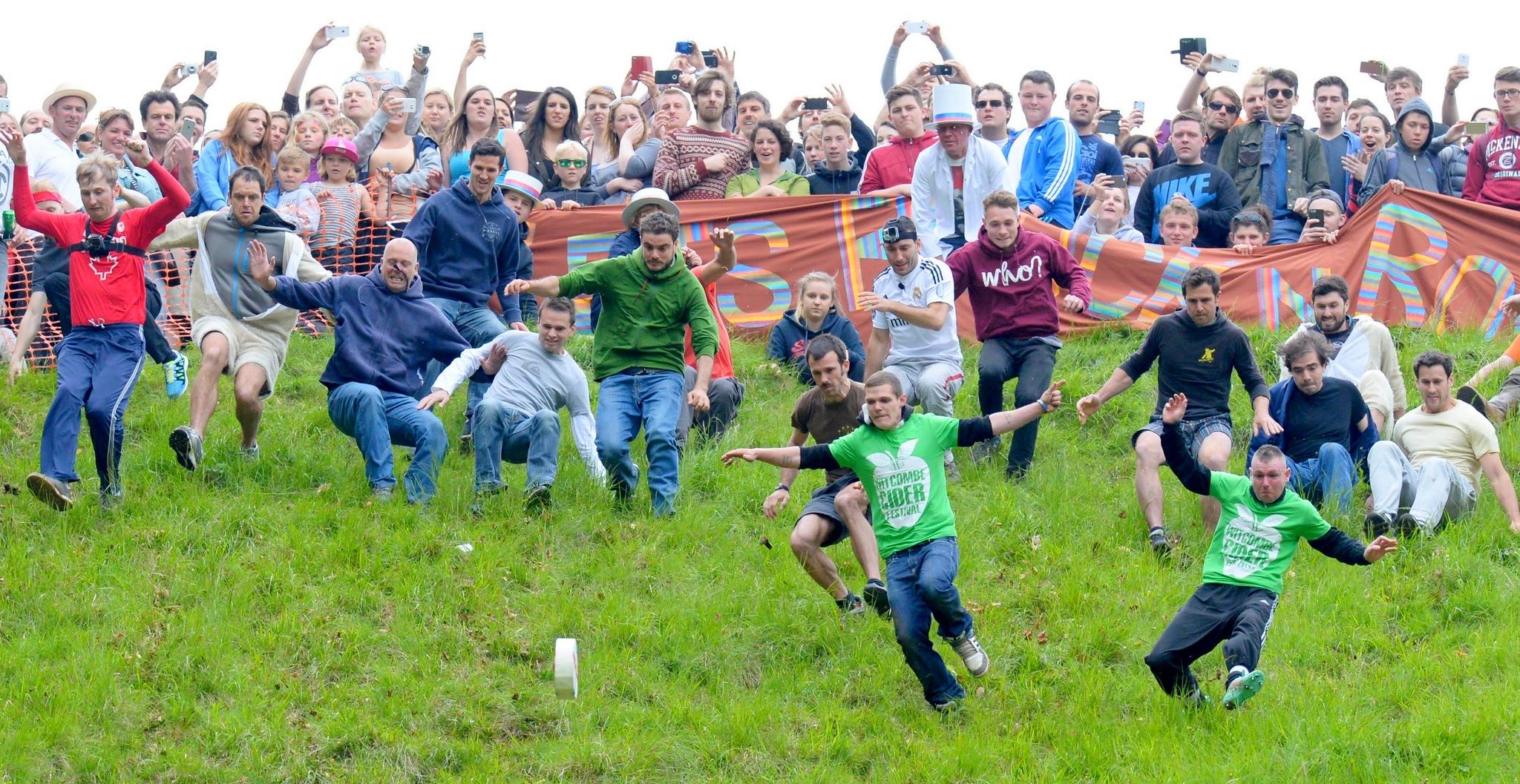The Challenge, the Chase, the Cheese: What Is British Cheese Rolling?
A cheese rolling contest in action
Cheese rolling may conjure visions of cheese curds being gently gathered by an artisanal cheese maker. In fact, it is neither gentle nor artisanal. Cheese rolling involves sending a wheel of cheese rolling down Gloucestershire’s dizzyingly steep Cooper’s Hill. Then contestants run after it. Catching the cheese, a 7-pound Double Gloucester, mid-chase is a non-starter. It’s been clocked at upwards of 70 miles per hour. The laws of physics are against you. So are the odds of remaining upright. Bruises, sprains and broken bones are common. But, as cheese rolling fans are proud to say, there’ve never been any fatalities, and the sport goes back centuries.
History of Cheese Rolling
Though some historians trace the event back to Britain’s Roman era, the earliest date on record is 1837, according to food historian, Emma Kay. ”Britain just loves its quirky and dangerous traditions,” says Kay, author of Stinking Bishops and Spotty Pigs: Gloucestershire’s Food and Drink (Amberley Publishing).
“Like most customs we continue to honor today in the UK, its origins are probably pagan. During the start of summer, it was common to set large bales of hay on fire down Cooper’s Hill in the village of Brockworth, Gloucestershire,” she says. “The hay, which would have been symbolic of burning away the last vestiges of winter, was replaced by Double Gloucester cheese at some stage, possibly because food during these types of festivals was linked to offerings or fertility. Certainly less dangerous!”
Double Gloucester Cheese
A hard cow’s milk cheese — from Gloucester cows, if you please, Britain’s oldest breed, Double Gloucester has a plush mouthfeel from full fat. It’s aged for 6 months, is less tangy than cheddar, with a more round and buttery flavor. The cheese has golden glow from annatto seeds and a slightly crumbly texture — until it meets heat, at which point it melts into gooey greatness. Single Gloucester, made with both whole milk and skim, is a lighter, perfectly lovely cheese, but it’s no Double Gloucester. Back in the 1700s, Double Gloucester was so prized, a wheel cost the equivalent of $240 today. Double Gloucester is a far more affordable treat now, ranging at $10 to $12 a pound, but perhaps free cheese tastes better. Every year, cheese rolling contestants think so.
In recent decades, cheese rolling’s prize Double Gloucester was made by Gloucester’s Diana Smart of Smart’s Farm. She took up cheese making in her 60s, and kept it up until she died at the age of 86, just prior to Covid. Cheese rolling was suspended for two years during the pandemic, but it was back this year, and so was Smart Farm’s Double Gloucester, made by Smart’s son, Rod.
When is Cheese Rolling?
Traditionally, the event takes place on Whit Monday, at the end of May. A local dignitary sets the cheese rolling, and then up to 20 contestants tear after it. “There is no protocol,” says Kay. “You just run down the hill with the cheese rolling in front of you. The race commences as soon as you drop the cheese. No one actually catches the cheese. It’s whoever manages to get to the bottom of the hill first. If you win the race, you win the cheese.”
Participating in Cheese Rolling
While the event mostly attracts locals, “Anyone can sign up to do it,” says Kay. The winner of this year’s men’s competition, Gloucestershire’s own Chris Anderson, has 22 previous cheese rolling victories, sustaining a bruised kidney, a broken wrist, and a concussion along the way. Anderson, now 34, and the father of two sons, declared this race — which took place on a cold, wet day — would be his last. The winner of the women’s competition, Abby Lampe, was a newbie, and a Yank, to boot. Lampe, 21, from North Carolina, had heard about cheese rolling, seen some of the event’s YouTube and Instagram videos, and decided this was worth a go.
It’s one thing to be intrigued by cheese rolling. It’s another to fly to another country to participate. Lampe did it for much for the same reason others scale Everest — because it’s there. With plans to meet friends in Barcelona for spring break anyway, she built in a visit to Gloucestershire.
An American Cheese Rolling Champion
Lampe arrived two days before the event and went to inspect the course. The English countryside is full of gently rolling hills. Cooper’s Hill is not one of them. It’s 182 meters (or 600 feet) long with a 1:2 gradient, which is to say nearly vertical. “It’s a lot steeper than I expected,” says Lampe. “I wanted to run down it. Slipping and sliding down half the hill was not planned.”
It happened, anyway. They call it cheese rolling, but there’s a fair amount of rolling and tumbling for participants, as well. For Lampe, who finished mud-caked but intact, it was more about chase than the cheese. By her own admission, she’s more of a Vermont cheddar kind of girl. One month after the race, she hadn’t even tasted her victory cheese. She shipped it home to Raleigh, where she’s become somewhat of a local celebrity. “It’s just so weird,” she says. “It only took running down a steep hill.”
Lampe has no plans to compete in future cheese rolling competitions. “It would be too embarrassing to go back and lose,” she says. But she’s looking forward to enjoying the cheese with friends and family. So what does a Vermont cheddar girl do with a 7-pound Double Gloucester? It makes for a superior grilled cheese sandwich experience, the people of Gloucestershire told her. Also lovely with crackers and a pint. Cheers.





